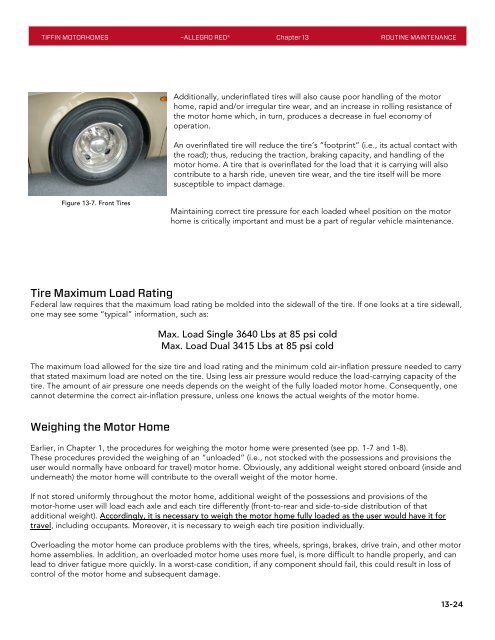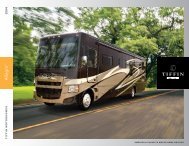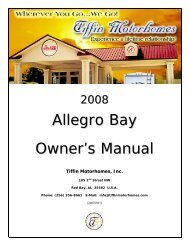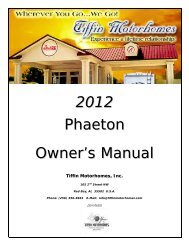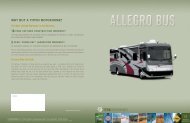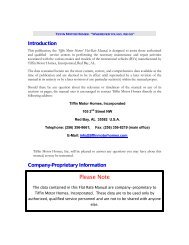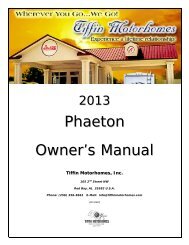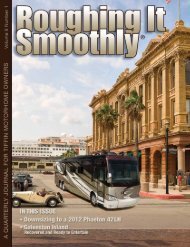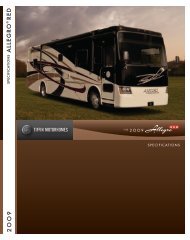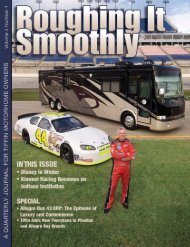Allegro RED Owner's Manual - Tiffin Motorhomes
Allegro RED Owner's Manual - Tiffin Motorhomes
Allegro RED Owner's Manual - Tiffin Motorhomes
- No tags were found...
You also want an ePaper? Increase the reach of your titles
YUMPU automatically turns print PDFs into web optimized ePapers that Google loves.
TIFFIN MOTORHOMES –ALLEGRO <strong>RED</strong>® Chapter 13 ROUTINE MAINTENANCEAdditionally, underinflated tires will also cause poor handling of the motorhome, rapid and/or irregular tire wear, and an increase in rolling resistance ofthe motor home which, in turn, produces a decrease in fuel economy ofoperation.An overinflated tire will reduce the tire’s “footprint” (i.e., its actual contact withthe road); thus, reducing the traction, braking capacity, and handling of themotor home. A tire that is overinflated for the load that it is carrying will alsocontribute to a harsh ride, uneven tire wear, and the tire itself will be moresusceptible to impact damage.Figure 13-7. Front TiresMaintaining correct tire pressure for each loaded wheel position on the motorhome is critically important and must be a part of regular vehicle maintenance.Tire Maximum Load RatingFederal law requires that the maximum load rating be molded into the sidewall of the tire. If one looks at a tire sidewall,one may see some “typical” information, such as:Max. Load Single 3640 Lbs at 85 psi coldMax. Load Dual 3415 Lbs at 85 psi coldThe maximum load allowed for the size tire and load rating and the minimum cold air-inflation pressure needed to carrythat stated maximum load are noted on the tire. Using less air pressure would reduce the load-carrying capacity of thetire. The amount of air pressure one needs depends on the weight of the fully loaded motor home. Consequently, onecannot determine the correct air-inflation pressure, unless one knows the actual weights of the motor home.Weighing the Motor HomeEarlier, in Chapter 1, the procedures for weighing the motor home were presented (see pp. 1-7 and 1-8).These procedures provided the weighing of an “unloaded” (i.e., not stocked with the possessions and provisions theuser would normally have onboard for travel) motor home. Obviously, any additional weight stored onboard (inside andunderneath) the motor home will contribute to the overall weight of the motor home.If not stored uniformly throughout the motor home, additional weight of the possessions and provisions of themotor-home user will load each axle and each tire differently (front-to-rear and side-to-side distribution of thatadditional weight). Accordingly, it is necessary to weigh the motor home fully loaded as the user would have it fortravel, including occupants. Moreover, it is necessary to weigh each tire position individually.Overloading the motor home can produce problems with the tires, wheels, springs, brakes, drive train, and other motorhome assemblies. In addition, an overloaded motor home uses more fuel, is more difficult to handle properly, and canlead to driver fatigue more quickly. In a worst-case condition, if any component should fail, this could result in loss ofcontrol of the motor home and subsequent damage.13-24


